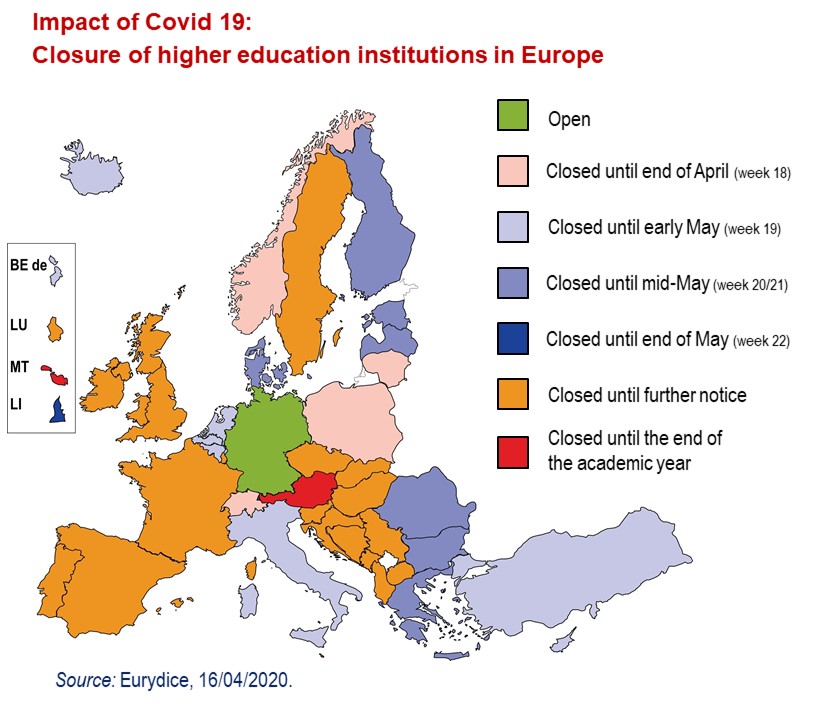
In 11 March 2020 the World Health Organization declared Covid a pandemic and since then a significant part of the activities of various sectors have had to be reformulated to meet the new health and safety criteria, with education, it was no different, directly affecting a total of approx. 897 million students who attend school, not to mention higher education. However,, what draws attention was how a considerable number of european countries dealt with the impasses, as several nations were able to return to school in a few days.
Letícia Fadlallah, during the second wave of COVID-19 in Europe, many countries chose to maintain restrictions, each with its specificity, for the population, in order to avoid contagion of the population and prevent the health system from collapsing. However,, several European nations have chosen to keep certain establishments closed while schools remain open, and this decision was made due to several reasons. One of them, is the fact that the minority of COVID cases in European Union countries have been identified in children, near 5% only according to ECDC (Center for Disease Control and Prevention in Europe). Besides that, there was a huge concern about the negative effects that removal of young people from face-to-face school activities could cause, mainly on the mental health of these people.
It is worth mentioning, that there are different arguments about face-to-face classes in Europe during the pandemic. For example, Scottish political leaders said face-to-face school activities had not contributed to the spread of the disease, on the other hand, Irish authorities reinforced their concern about the reopening of schools, in addition to emphasizing that they did not want young Irish people to also fall victim to the pandemic.
Besides that, some countries were a reference in terms of maintaining classes in this very difficult time. Standing out France and Germany that used various health measures to avoid contagion even with students attending classes in person. One of the main measures used was the distancing, which should have a spacing of one meter between students, in addition to only allowing 15 students inside the classroom and the modification of class schedules, in which schedules were made that planned the rotation of students in classrooms.
In this way, when heading to Europe, more specifically, for the following countries: Finland, Norway, France, Germany, Denmark, Estonia and Ireland, it can be seen that these States had their schools closed for a maximum of 70 days. still, a comparison with countries outside the continent that have chosen to close their schools, like Brazil, Costa Rica, Colombia, demonstrate that even with the lower circulation of students, these places failed to achieve better results regarding Covid, as they resemble the numbers of people infected by covid-19, something between 40-60 thousand per million inhabitants. It is worth mentioning, that all the European nations mentioned above maintained a number less than or equal to 40 thousand cases of infected people.[1]
In addition, another point that must be emphasized for the analysis of the situation is the position of the PISA ranking (Programme for International Student Assessment) both from the point of view of those who succeeded and those who did not (or took too long) to reopen schools – bearing in mind that PISA scales the quality index of education in countries and, consequently, the structure and competence of teaching. In this way, when observing the regions that occupy high positions there is a parallel with the number of days that schools were closed, as the countries with the worst education indicators are evaluated, more days were needed to be able to open.
Therefore, part of the explanation for the fact mentioned above is due to the strong capacity of the countries that top the PISA rankings to adapt to the new sanitary conditions required by the pandemic, because they already had considerable teaching structures, they had an advantage compared to others and could make the school environment safer without so many drastic changes. Therefore, there was a clear difference in organization and logistics on the part of Europe in relation to other regions that do not have a similar infrastructure. After all, while the European countries mentioned hold scores between 480-520 (being 600 full note), Costa Rica, Brazil and Colombia are among those listed with scores between 400-440 in the reading ranking, for example. The same situation applies to math and science indices.
However, with regard to higher education, because they already have greater autonomy compared to high school students, ended up migrating to the online format, after all, the European Union report states that 89,3% of students own computers. However,, even with this high percentage, other variables concern, how: 60% reported that they do not always have a reliable internet connection and 34,4% of students said they don't usually have a quiet place to study.
Given the above, it is possible to say that Europe in relation to other regions was not very affected by the pandemic in the area of education, and this is due to several factors. One of them, is the fact that the European continent is quite developed, which makes several families have favorable conditions to keep their children studying at home, or even in a hybrid programming, in which on some days of the week students attend classes in person, and on other days they watch them online from home, for both high school and college students. In addition, Of course, of the security guaranteed by the infrastructure that allow the realization of the few classes.
By Gustavo Cunha and Matheus Colucci
References:
Coronavirus: the strategies and challenges of countries that are reopening their schools. BBC. Available in: https://www.todamateria.com.br/referencia-site-abnt/#:~:text=Referência de site de jornal,Seção (case exists). Access in: 10 June 2021.
Chad, Jamil. Europe faces covid-19 on back-to-school with new manual for going to school. Twitter. Available in: https://noticias.uol.com.br/colunas/jamil-chade/2020/09/06/volta-as-aulas-suica-europa-covid-19.htm. Access in: 10 June 2021.
Estela de Souza Pinto, Well. Countries with a strong education network closed schools for fewer days, says OECD. Newspaper. Available in: https://paywall.folha.uol.com.br/folha/retorno?done=https://www1.folha.uol.com.br/mundo/2021/04/paises-com-rede-de-ensino-forte-closed-schools-for-less-days-diz-ocde. shtml?origin=folha. Access in: 10 June 2021.
Santana, Felipe. Even with the new wave of Covid-19, countries keep schools open to minimize impact of the pandemic on education. G1. Available in: https://g1.globo.com/educacao/noticia/2020/12/07/mesmo-com-nova-onda-de-covid-19-paises-mantem-escolas-abertas-para-minimizar-impacto-da-pandemia-na-educacao.ghtml. Access in: 10 June 2021.
France closes schools and announces nationwide quarantine extension for a month. Or Balloon. Available in: https://oglobo.globo.com/mundo/franca-fecha-escolas-anuncia-extensao-da-quarentena-para-todo-pais-por-um-mes-24949899. Access in: 10 June 2021.
Oliveira, Juliana. Back to school in the pandemic: what the schools of Europe have to teach us. State of Minas. Available in: https://www.em.com.br/app/noticia/educacao/2020/09/21/internas_educacao,1187232/back-to-school-in-the-pandemic-what-europe-schools-have-to-teach.shtml. Access in: 10 June 2021.
The impact of COVID-19 on higher education: a review of emerging evidence. European Commission. Available in: https://op.europa.eu/en/publication-detail/-/publication/876ce591-87a0-11eb-ac4c-01aa75ed71a1/the-language. Access in: 23 June 2021.
[1] Information corresponding to December 2020.
